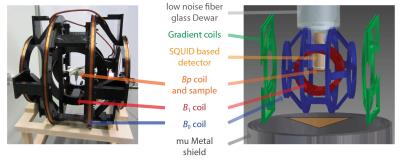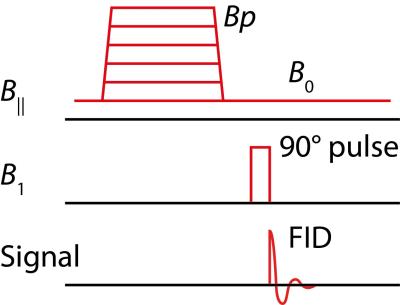3033
SQUID-based ultralow field nuclear magnetic resonance spectroscopy using the para-H2 based hyperpolarization technique SABRE1High-field Magnetic Resonance, MPI for Biological Cybernetics, Tuebingen, Germany, 2Physikalisches Institut and Center for Quantum Science (CQ) in LISA+, University of Tübingen, Germany, 3Institue of Inorganic Chemistry, University of Tübingen, Germany, 4Department for Biometrics and Medical Informatics, Otto-von-Guericke-University Magdeburg, Germany
Synopsis
SABRE is a technique to achieve continuous hyperpolarization for MR measurements by the interaction of para-hydrogen and a substrate via steady ligand exchange on a catalyst. Thus, MR-active nuclei can be hyperpolarized more than only once. At field strengths of mT Faraday coils, commonly used in conventional or high field MRI, become insensitive and SQUIDs performing superior. Since SQUIDs are broadband detectors, the static magnetic field B0 can be changed easily or multiple nuclei can be measured simultaneously. Here, we successfully demonstrate the advantages of a SQUID based system by showing significant signal enhancement (1H, 19F) by hyperpolarization of 3-fluoropyridine.
Introduction:
Recently, it was shown that Signal Amplification By Reversible Exchange (SABRE) is a novel technique to produce continuous hyperpolarization for NMR and MRI.1,2 This method, which enables 1H signal enhancements up to 105, bases on a symmetry breaking mechanism that converts the para-hydrogen (para-H2) spin order into polarization. This process is caused by an interaction of para-H2 and the substrate of interest via an Ir-based catalyst system. Continuous hyperpolarization of substrates like pyridine or nicotinic acids in solution is possible because of a continuous ligand exchange. In contrast to the standard Para-H2 Induced Polarization (PHIP) approach, no hydrogenation of the precursor molecule is required and the enhanced substrate can be re-hyperpolarized. In addition, signals of MR-active heteronuclei (such as 15N or 19F) can be increased.1,3 The optimal field strength for SABRE depends on the substrate and the nuclei to be polarized. However, the magnetization transfer reaction from 1H to 19F takes place in the range of 2 – 10 mT. A Superconducting QUantum Interference Device (SQUID)-based NMR system operating at these field strengths not only has a higher SNR, compared to a system using a Faraday coil,4 but also can detect the NMR signal of multiple nuclei simultaneously. SQUIDs are broadband detectors, which are able to detect the magnetic flux directly rather than the change of the magnetic field making them sensitive from DC up to the GHz range.5Methods:
The SQUID based ultralow field (ULF) NMR system consists of a tetracoil used to generate the B0 field, a B1 coil in a Helmholtz configuration, a prepolarizing Bp coil and the heart of the system, the SQUID based magnetic field detector sitting inside a liquid helium filled low-noise fiber glas dewar (Fig. 1).6,7 A pickup coil in a second order gradiometer configuration is used with a loop diameter of 40 mm and a baseline of 40 mm. The gradiometer is sensitive to the sample, which locates 12 mm (the hot to cold distance of the dewar) below the lowest loop and it rejects signals from distant noise sources.
Due to the fact that SQUIDs are sensitive to signals from the DC up to the GHz range, the whole system is put inside a cylindrical mu metal shield for magnetic shielding and inside a steel-shielding chamber for shielding HF noise.
As a sample holder, we used a vessel with sample volume of 2 ml. The para-H2 was continuously delivered at the bottom of the vessel and bubbled through the sample. At the top part, a small hole permitted the para-H2 outflow. The para-H2 was produced on-site during the experiment with a home-made para-H2 generator operating in a liquid helium bath.
The measured samples consisted of 114.8µl 3-fluoropyridine and 43.9mg Ir-IMes catalyst ([Ir(COD)(IMes)(Cl)]), dissolved in 5ml methanol at room temperature. The pulse sequence for acquiring the NMR spectra is shown in Fig. 2. A Bp pulse was used to increase the B0 field strength to the maximum of the magnetic transfer reaction. After the adiabatic switch off of the Bp field a 90° B1 pulse followed. A double resonant pulse can be used to excite multiple kernels simultaneously. Afterwards the Free Induction Decay (FID) was read out.
Results:
Simultaneously detected 1H (~3350 Hz) and 19F (~3155Hz) MR signals were observed in the SQUID-based MR spectrum of hyperpolarized 3-fluoropyridine [Fig. 3 (a) and (b)]. Without hyperpolarization no signal could be detected. The 19F signal displays the 1H-19F couplings, estimated from a 19F spectrum measured at high magnetic fields. High-field spectra of 3-fluoropyridine in methanol-d4 were performed with a Bruker WB-300 system. Figure 4 displays the 19F NMR signal (7 T, spectrum in thermal equilibrium) as well as the simulated signal based on the coupling constants listed in the table.Discussion:
We successfully demonstrated the combination of SQUID based ULF NMR with the para-H2 based hyperpolarization technique SABRE. 3-fluoropyridine could be hyperpolarized and both 1H and 19F signals were detected. Due to J-coupling multiple peaks were observed and compared to a high resolution 7 T NMR spectrum.Conclusion:
SQUID based ULF NMR allows the simultaneous detection of several MR active nuclei. The use of hyperpolarization techniques enable the measurement of nuclei with low spin density in the sample that otherwise would not be observable at low fields. These results demonstrate that a SQUID based NMR system is an optimal setup for the investigation of hyperpolarization techniques that work optimal in the mT range and below, e.g. SABRE or dynamic nuclear polarization.Acknowledgements
This work was supported by the Deutsche Forschungsgemeinschaft (BE 1824/12-1).References
[1] Adams RW, Aguilar JA, Atkinson KD, Cowley MJ, Elliott PIP, Duckett SB, Green GGR, Khazal IG, López-Serrano J, Williamson DC, Reversible Interactions with para-Hydrogen Enhance NMR Sensitivity by Polarization Transfer. Science 2009;323:1708-1711.
[2] Rovedo P, Knecht S, Bäumlisberger T, Cremer AL, Duckett SB, Mewis RE, Green GG, Burns M, Rayner PJ, Leibfritz D, Korvink JG, Hennig J, Pütz G, von Elverfeldt D, Hövener JB, Molecular MRI in the Earth's Magnetic Field Using Continuous Hyperpolarization of a Biomolecule in Water. J. Phys. Chem. B. 2016;120(25):5670-5677.
[3] Plaumann M, Euchner F, Ringleb R, Hadjiali S, Bargon J, Buntkowsky G, Bernarding J, Bommerich U, Hyperpolarization of fluorinated pyridine carboxylic acids. MAGMA 2016;29(Suppl. 1):370-371.
[4] Myers W, Slichter D, Hatridge M, Busch S, Mößle M, McDermott R, Trabesinger A and Clarke J, Calculated signal-to-noise ratio of MRI detected with SQUIDs and Faraday detectors in fields from 10 µT to 1.5 T. J. Magn. Res. 2007;186:182-192.
[5] Clarke J, Braginski AI, The SQUID Handbook: Vol. II Applications of SQUIDs and SQUID Systems. Wiley-VCH, 2006.
[6] Gottardi G, Mesirca P, Agostini C, Remondini D and Bersani F, A four coil exposure system (tetracoil) producing a highly uniform magnetic field. Bioelectromagnetics 2003;24:125-133.
[7] Seton HC, Hutchison JMS and Bussell DM, Liquid helium cryostat for SQUID-based MRI receivers. Cryogenics 2005;45:348-355.
Figures



